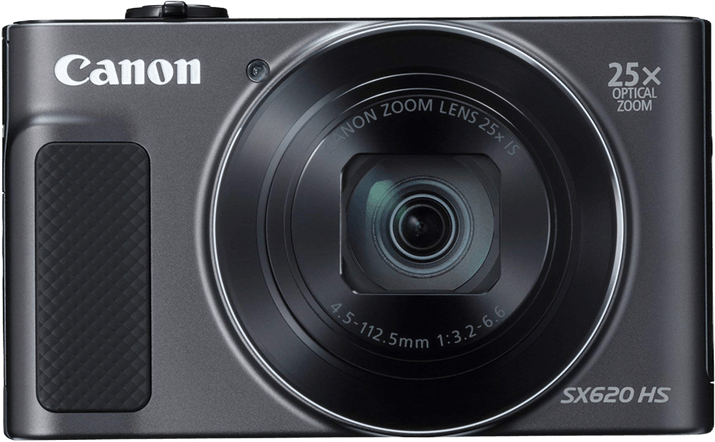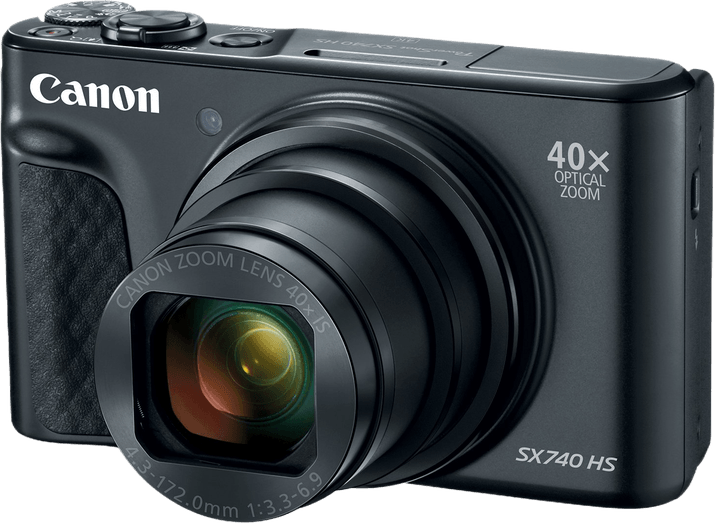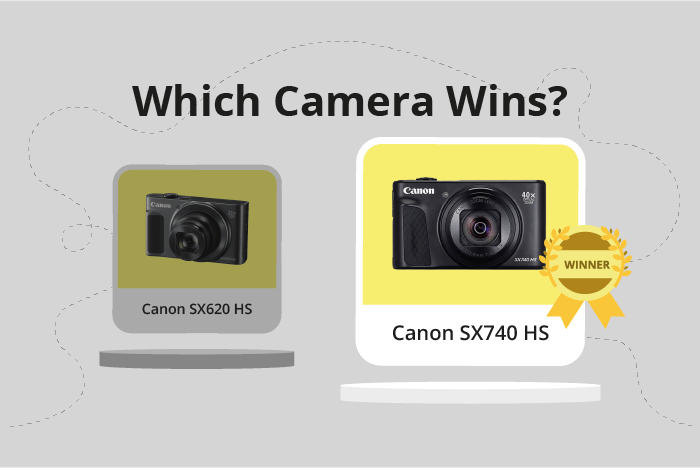Canon PowerShot SX620 HS vs PowerShot SX740 HS Comparison
Canon PowerShot SX620 HS

Canon PowerShot SX740 HS

The Canon PowerShot SX740 HS takes the lead with a score of 52/100, while the Canon PowerShot SX620 HS trails behind with a score of 49/100. Both cameras are compact in design and were launched at different times, with the SX620 HS in 2016 and the SX740 HS in 2018. They also differ in price, with the SX620 HS at $279 and the SX740 HS at $399.
The SX740 HS stands out with its larger dimensions (110 x 64 x 40mm) and heavier weight (299g), offering a more substantial feel. On the other hand, the SX620 HS is smaller (97 x 57 x 28mm) and lighter (182g), making it more portable and convenient for travel.
Despite their differences, both cameras share the same compact design and offer quality performance. The higher score of the SX740 HS reflects its improved features and design, while the lower score of the SX620 HS highlights its portability and affordability.
Canon PowerShot SX620 HS vs PowerShot SX740 HS Overview and Optics
The Canon PowerShot SX740 HS narrowly wins in optics with a score of 55/100, while the Canon PowerShot SX620 HS scores 54/100. Both cameras have several common features, including a CMOS sensor, fixed lens mount, image stabilization, and a 1/2.3″ sensor size. However, there are some key differences between the two models that contribute to their respective scores.
The SX740 HS has a slight advantage with 21 megapixels, compared to the SX620 HS’s 20 megapixels. This allows for better image resolution and detail. Additionally, the SX740 HS boasts a significantly faster shooting speed of 10 frames per second, compared to the SX620 HS’s 2.5 frames per second. This faster speed is beneficial for capturing action shots and reducing motion blur. Furthermore, the SX740 HS has a more advanced processor, the Digic 8, which contributes to improved image processing and overall camera performance.
Despite these advantages, the SX620 HS has a higher DXOMARK score for its sensor, at 65 compared to the SX740 HS’s 58. This means that the SX620 HS’s sensor has better overall image quality and low-light performance. Additionally, the SX620 HS has a 4:3 aspect ratio, which is more suitable for certain types of photography, such as portraits and landscape shots.
Both cameras have their strengths and weaknesses, with the SX740 HS excelling in megapixels, shooting speed, and processing power, while the SX620 HS has a superior sensor quality and a more versatile aspect ratio. The SX740 HS slightly edges out the SX620 HS in terms of optics, but the choice between the two ultimately depends on individual preferences and specific photography needs.
Canon PowerShot SX620 HS vs PowerShot SX740 HS Video Performance
The Canon PowerShot SX740 HS emerges as the superior camera in terms of video capabilities, with a score of 83/100 compared to the Canon PowerShot SX620 HS’s score of 43/100. This difference in scores highlights the significant gap in video performance between these two cameras.
Both cameras share some common video specifications, such as the ability to record in Full HD resolution. However, the similarities end there, as the SX740 HS outshines the SX620 HS in various aspects. The SX740 HS offers 4K video resolution with maximum dimensions of 3840 x 2160, which is a substantial improvement over the SX620 HS’s maximum video dimensions of 1920 x 1080. Additionally, the SX740 HS boasts a higher maximum video frame rate of 60fps, as opposed to the SX620 HS’s 30fps. This higher frame rate allows for smoother and more detailed videos. Moreover, the SX740 HS features built-in time-lapse functionality, while the SX620 HS does not.
The SX620 HS, however, does not possess any notable advantages over the SX740 HS in terms of video capabilities. Its lower score reflects its limited features and performance in this area.
Taking these factors into consideration, it is evident that the Canon PowerShot SX740 HS is the superior choice for those prioritizing video capabilities. Its higher score is well-deserved, thanks to its 4K resolution, increased frame rate, and time-lapse functionality. On the other hand, the Canon PowerShot SX620 HS falls short in comparison and may not be the ideal choice for users who require advanced video features.
Canon PowerShot SX620 HS vs PowerShot SX740 HS Features and Benefits
The Canon PowerShot SX740 HS outperforms the Canon PowerShot SX620 HS in terms of features, scoring 54/100 compared to the SX620 HS’s 41/100. Both cameras share several specifications, including a 3-inch screen size, a screen resolution of 922,000 dots, a flip screen, and WiFi connectivity. Neither camera has GPS or a touchscreen. However, the SX740 HS has additional advantages, which contribute to its higher score.
One significant advantage of the SX740 HS is the inclusion of Bluetooth connectivity. This feature allows for seamless pairing with smartphones and other devices, making it easier to transfer photos and control the camera remotely. The SX620 HS lacks this capability, which may limit its appeal for users who value wireless connectivity options.
Despite these differences, the SX620 HS still has some merits. Its feature score of 41/100, while lower than the SX740 HS, is not insignificant. Both cameras have a flip screen and WiFi connectivity, which are essential features for many users. The SX620 HS may also be more affordable than the SX740 HS, making it a suitable choice for budget-conscious buyers.
Taking all of these points into consideration, the Canon PowerShot SX740 HS is the superior camera in terms of features. Its Bluetooth connectivity sets it apart from the SX620 HS, offering enhanced functionality and convenience. However, the Canon PowerShot SX620 HS remains a viable option for those seeking a more affordable camera with essential features like a flip screen and WiFi connectivity.
Canon PowerShot SX620 HS vs PowerShot SX740 HS Storage and Battery
The Canon PowerShot SX620 HS outperforms the Canon PowerShot SX740 HS in storage and battery with a score of 29/100, compared to the SX740 HS’s score of 16/100. Both cameras share common specifications: they each have one memory card slot, accept SD/SDHC/SDXC memory cards, and use the NB-13L battery type.
The SX620 HS has an advantage in battery life, offering 295 shots compared to the SX740 HS’s 265 shots. Additionally, the SX620 HS supports USB charging, which the SX740 HS lacks. This makes the SX620 HS more convenient for on-the-go charging.
In contrast, the SX740 HS accepts UHS-I compatible memory cards, which allow for faster data transfer rates. However, this advantage is not significant enough to outweigh the better battery life and USB charging capabilities of the SX620 HS.
Considering the differences in storage and battery, the Canon PowerShot SX620 HS is the better choice for those prioritizing longer battery life and USB charging convenience, while the SX740 HS is suitable for users who require faster data transfer with UHS-I compatible memory cards.
Canon PowerShot SX620 HS vs PowerShot SX740 HS – Our Verdict
Are you still undecided about which camera is right for you? Have a look at these popular comparisons that feature the Canon PowerShot SX620 HS or the Canon PowerShot SX740 HS:

